What Animals Live In.homes In.the Ground Soth Central Wisconsin
There are nineteen species of furbearers in Wisconsin. Most autumn into the carnivore group (Lodge Carnivora), but two species are rodents and ane is a marsupial.
A furbearer is a mammal whose fur has commercial value. Traditionally, these are the mammals trapped for their fur, though non all of Wisconsin'due south furbearers may be harvested in the nowadays 24-hour interval.
View the 2020 furbearer fall forecast.
Coyote (Canis latrans): The coyote is a medium-sized member of the canine family. The average coyote weight is between 20-30 pounds, though they can weigh upward to l pounds. Coyote fur can be a variety of colors including grayness, tawny, reddish, blond and black. They are opportunistic omnivores (meaning they will eat annihilation), merely primarily consume deer (specially fawns and roadkills), rabbits, modest mammals and fruit. They give nascence in late spring to two to eight immature. Coyotes will form packs; generally, these packs are family unit groups, including a convenance male and female, immature from the current yr and young from the previous year. Learn how to tell a coyote from a wolf. Coyotes may exist hunted twelvemonth-round with the appropriate license, though the trapping season is restricted.
Crimson pull a fast one on (Vulpes vulpes): Ruddy foxes, a fellow member of the canine family, have cherry fur and a bushy tail that most of the fourth dimension has a white tip. At that place are different color phases of ruby trick, including black, silverish and a cross between ruby and argent. They are opportunistic but more often than not eat modest mammals, rabbits, squirrels and birds. They tend to be solitary. They only use dens to raise immature just will find embrace during the day to rest. Blood-red foxes are adjustable and can be plant in rural, suburban and urban areas. At that place is a restricted trapping flavor on reddish foxes and a license is required.
Gray fox (Urocyon cinereoargenteus): The gray flim-flam is the smallest canine found in Wisconsin. Gray foxes, every bit their name suggests, take gray fur with white on the chins and throats and brown undersides. They have a black stripe downwardly the top of their tail and exercise not have the white tip like cherry foxes do. They are unique because they have semi-retractable claws that allow them to climb copse, and they are i of only two canine species in the earth that tin can practise so. They are more than common in southern Wisconsin. There is a limited trapping flavor on the gray fox that requires the advisable license.
River otter (Lontra canadensis): The river otter is a large, semi-aquatic member of the weasel (or mustelid) family. They are long-bodied, curt-haired furbearers with a powerful, thick tail used for swimming. They leap, bound, slide and play-fight to keep in shape for hunting. Their fur is a night brown with lighter colored throats and bellies. Males can be upward to 25 pounds, whereas females tend to exist nineteen pounds or less. Otters have webbed toes and valves in their nose and ears that they tin close when underwater, both adaptations to aid them swim. They accept one litter per year with an average of ii to 3 young per litter. They eat primarily fish, though they also may swallow crayfish, frogs, muskrats and reptiles.
Fisher (Martes pennanti): The fisher is a medium-sized member of the weasel family. Fisher are nighttime brown to almost black in color with bushy tails. Developed males counterbalance around 15 pounds with females being about 25% smaller. Fisher have one litter of ane to five kits per year. Fisher have been known to out-maneuver squirrels in the trees and to successfully casualty upon the well-guarded porcupine. Fisher were reintroduced to Wisconsin in the 1950s. By the 1980s, their population had rebounded enough to have a express harvest. In Wisconsin, a special let is required to harvest a fisher.
Badger (Taxidea taxus): The badger, Wisconsin'due south land mammal, is a wide-bodied, short-legged mustelid (member of the weasel family) with long, powerful claws used for digging. The annoy has a grizzled gray appearance and distinctive blackness patches on its confront and a white stripe from its nose to partway downward its dorsum. The average adult size is 12-16 pounds. Badgers dig burrows, sometimes with multiple tunnels and chambers. Frequently, they will dig new burrows instead of using one-time burrows. Badgers are solitary except during breeding season. They forage by earthworks up ground squirrels, moles and other pocket-size mammals. The annoy is a non-game species and may non be harvested in Wisconsin. Recently, a graduate student at UW-Madison studied badgers in the southwestern portion of Wisconsin and a graduate student at UW-Milwaukee is final a annoy genetics report.
American (pine) marten (Martes americana): The marten is Wisconsin's endangered furbearer. A member of the weasel family, this one-iii.5 pound mammal is proficient at climbing copse.
give birth betwixt March and May to three to four young, commonly in tree dens, though they will also den in fallen logs, rocks, squirrel nests and woodpecker holes. Once extirpated from Wisconsin, they were re-introduced and are now plant primarily in and around the Chequemagon-Nicolet National Forest. In 2008-2010, a second wave of reintroductions was made to supplement Wisconsin's existing population. They adopt large areas of mature or old-growth upland conifer and northern hardwood forests, specially with a lot of fallen timber and downed woody debris. Marten may not be harvested in Wisconsin and special "marten protection zones" be with limited trapping to avoid incidental capture of this species. Learn how trappers can avoid marten [PDF]. Inquiry on martens is ongoing. Learn more near this endangered mammal.
Mink (Neovison vison): The mink is a semi-aquatic furbearer common throughout Wisconsin. These carnivores have short, dumbo, chocolate-colored fur and may have white patches on their chest and belly. Mink generally weigh 1.5-2 pounds with males being larger than females. They swallow muskrats, fish, reptiles, amphibians, waterfowl, eggs and small mammals like mice. While they adopt to chase around h2o bodies, they will travel and forage for nutrient in upland habitats as well. Like all members of the weasel family, mink have delayed implantation, significant the fertilized egg doesn't implant to the uterine wall immediately. Mink requite birth in belatedly spring to v-six young. Mink may exist harvested during a limited, regulated season with the advisable license.
Long-tailed weasel (Mustela frenata): The long-tailed weasel is the largest weasel constitute in Wisconsin, though they are only slightly larger than the more common curt-tailed weasel. They are normally 13-18 inches long with a black-tipped, four-6 inch tail. They are brownish on top with white or cream-colored throats or bellies, simply like all three species of weasels in Wisconsin, their fur may turn completely white in the winter. Similar all mustelids, the long-tailed weasel has delayed implantation, then they breed in July but don't requite birth until the next bound. Weasels den in hollow stumps, tree roots, rock piles or under buildings and have an average of six young. Small mammals, rabbits and birds are the common prey items. All iii species of weasel may be trapped year-round with a trapping license.
Short-tailed weasel (Mustela erminea): The short-tailed weasel is the virtually abundant weasel in Wisconsin. At effectually a foot long, the short-tailed weasel is smaller than the long-tailed weasel and has a 2-four inch tail with a black tip. They are like in color to the long-tailed and, like the long-tailed, their fur may turn white in the winter. Long-tailed and short-tailed weasels tin can exist difficult to tell apart, but in near parts of the state the short-tailed weasel is the most likely to be seen. Tail length is the only good way to distinguish between the ii, simply it can be challenging to tell in the wild. Similar most members of the weasel family, they are nocturnal, and they consume similar prey to the long-tailed weasel. Weasels may exist trapped year-round by those possessing a valid trapping license.
To the lowest degree weasel (Mustela nivalis): The smallest of the weasels found in Wisconsin, the least weasel is about six inches long, with a short tail. They are the smallest living carnivore in the earth. Unlike the other two weasels in Wisconsin, to the lowest degree weasels don't have blackness tips on their tails, though they may take a few black hairs. Least weasels, like all Wisconsin weasels, may turn completely white in winter. Their reproduction is like to other weasels, as they accept six young in spring and den in hollow stumps, tree roots or rock piles. They also have similar diets to the other two species of weasel, preying primarily on small mammals and birds. Their modest size means they are hard to trap and their fur does non have much commercial value, though the pelts are used for instruction. Least weasels may be harvested year-round with a valid trapping license.
Beaver (Brush canadensis): Wisconsin was settled by traders looking to purchase beaver pelts from Native Americans. Beaver fur was used to make high-quality hats popular at the time. The beaver is the 2d-largest rodent in the world and can weigh upward to 80 pounds, though the average weight is 40-50 pounds. They are aquatic rodents and accept big, flat, scaled tails that are very distinctive. Beavers live in family groups and are known for being habitat engineers. They build dams to block flowing water to class wetlands and ponds and live in large houses they construct. They requite nativity to ii-5 kits in May or June and young disperse after 2 years with their parents. Beaver may be trapped during a regulated season with a valid trapping license and taken by landowners when harm is occurring.
Muskrat (Ondatra zibethicus): Muskrats are 1 of the nearly valuable furbearers in Wisconsin in present twenty-four hours. They are pocket-size, brown-furred aquatic rodents with scaly tails. Muskrats build feed beds, or loose rafts of vegetation, that they sit on in order to eat the aquatic vegetation they prefer. They build "houses" that they live and enhance their young in, which are piles of mud, sticks, grass, cattails and other aquatic vegetation with chambers inside, or they alive in dens dug into banks. In a adept habitat with fantabulous food resources, they can brood upwardly to four times a yr and can have anywhere between 1-11 immature per litter. Young muskrats are on their own in three-iv weeks and can exist sexually mature at six months of historic period. Muskrats may exist harvested during a regulated season in the winter with the appropriate license.
Bobcat (Lynx rufus): The bobcat is our almost-seen member of the cat family, though it is still uncommon in some areas of Wisconsin. They average xx-30 pounds and have light brown fur with spots and a short tail with blackness bands on the peak of the tail. Similar all cats, bobcats can brood year-round, though they commonly only have one litter of 2-iv kittens per year. Historically a northern Wisconsin species, in recent years sightings take increased in the primal and southern portions of the state. Bobcats are solitary except when breeding. Common food items include rabbits, minor mammals and deer. Research on bobcats is ongoing in Wisconsin. A special allow is required to harvest a bobcat.
Canada lynx (Lynx canadensis): Canada lynx are very uncommon in Wisconsin and we usually only meet rare visitors from Canada. Canada lynx are a federally threatened species and as such are protected in Wisconsin. Lynx resembles bobcats except that they accept solid black on the pinnacle and lesser of their tail instead of bands on the peak like bobcats. They also tend to have longer ear tufts and very large anxiety. Of the iii cat species nosotros occasionally see in Wisconsin (bobcat, lynx and cougar), lynx have the largest tracks. Their big, furred feet human activity every bit snowshoes to permit them to walk on top of snow. They primarily swallow hares, though they will also consume rabbits and small mammals. Lynx are known for having circadian populations (pregnant populations increase to a peak over a few years so decrease to a low over a few years) that represent with snowshoe hare population cycles. Lynx may not be harvested in Wisconsin. If you are a trapper, learn how to avoid lynx [PDF]. If you see a lynx, please complete the rare mammal reporting form.
Raccoon (Procyon lotor): Raccoons are a mutual and well-known furbearer in Wisconsin. They accept distinctive black masks and ringed tails that are easily recognizable. As generalists, they can live near anywhere and will eat most annihilation. Raccoons may exist trapped during a limited, regulated season with the proper license, though animals causing damage may be removed during other times of the year.
Opossum (Didelphis virginiana): The opossum is the merely marsupial (or pouched mammal) in Wisconsin. They have hairless, prehensile tails which they tin can utilize to grasp tree branches. They take the virtually teeth, l, of any Due north American mammal. Male person opossums average 6-7 pounds, though females tend to exist smaller. Opossums may have 5-thirteen young, though when they are born, the whole litter can counterbalance less than a penny. Opossum are omnivorous, meaning they will eat whatever plant or animal they come across. Historically a southern species, the range of the opossum is creeping northward, though opossum's ears in the n will ofttimes show signs of frostbite. Grinners, as opossums are sometimes called in the trapping earth, may exist harvested yr-round in Wisconsin with the appropriate license.
Striped skunk (Mephitis mephitis): The striped skunk is a very distinctive mammal. Once idea to be in the weasel family, they are at present in their own family with the five other species of skunks [exit DNR] found in North America. They average 4 to half-dozen pounds in weight and have long, bushy tails. They are well-known for their black fur with white stripes and their stiff musk they spray as a defence. This musk is actually used every bit a base in many high-quality perfumes. Averaging half dozen immature, striped skunks give nascence in May. They are nocturnal, meaning active at nighttime, like most of the furbearers of Wisconsin. Their preferred food is mice, insects, fruits, carrion, eggs, reptiles and amphibians. Skunks may be harvested year-round in Wisconsin with a valid license.
Spotted skunk (Spilogale putoris): Historic records have documented the spotted skunk in the southwestern corner of Wisconsin, but at that place have been no records of them in the state for several decades. They take the same black fur as striped skunks only have white blotches all over instead of the distinctive white back stripes of striped skunks. Formerly mutual to farmland areas of Wisconsin, they are now establish in the western plains states and in the southern U.S. The spotted skunk is smaller than the striped skunk at 1-four pounds Information technology has the same strong musk smell as striped skunks and stands on its front feet and stamps its feet when information technology feels threatened. Diet and convenance are similar to the striped skunk. If y'all see a spotted skunk or certificate one on a trail photographic camera, please report it to the assistant furbearer ecologist.
Wolves and black bears, though their fur may exist used for rugs or as taxidermy mounts, are commonly considered large carnivores. Cougars are a rare mammal in Wisconsin.
Source: https://dnr.wisconsin.gov/topic/WildlifeHabitat/furbearers.html
Posted by: johnstonrobse1937.blogspot.com

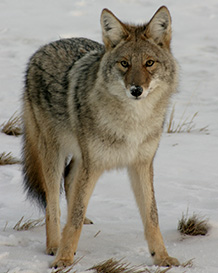
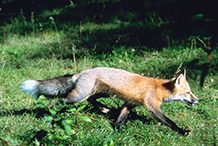
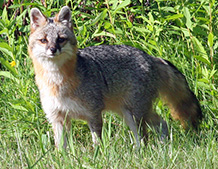
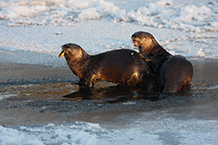
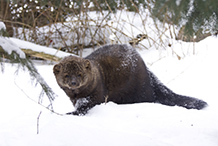

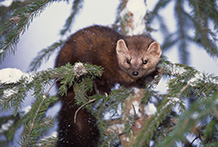
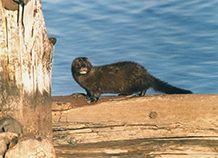
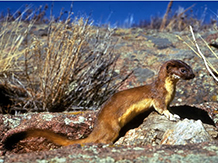
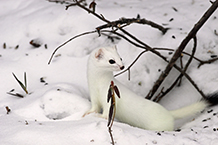
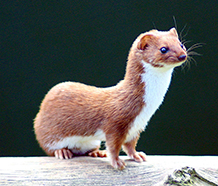
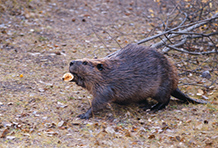
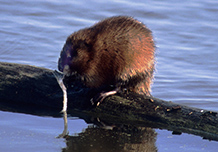
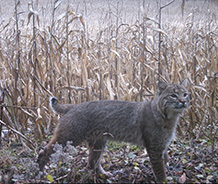
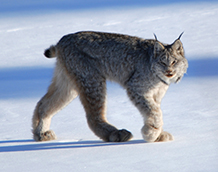
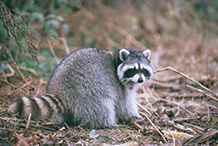
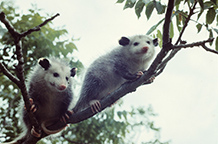
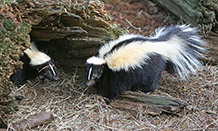
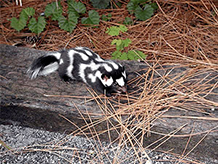
0 Response to "What Animals Live In.homes In.the Ground Soth Central Wisconsin"
Post a Comment